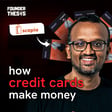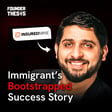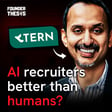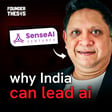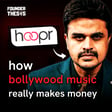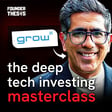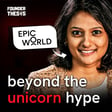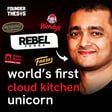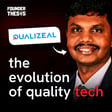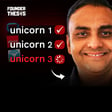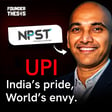Introduction to Zencaster and Podcast Goals
00:00:00
Speaker
Before we start today's episode, I want to give a quick shout out to Zencaster, which is a podcaster's best friend. Trust me when I tell you this, Zencaster is like a Shopify for podcasters. It's all you need to get up and running as a podcaster. And the best thing about Zencaster is that you get so much stuff for free. If you are planning to check out the platform, then please show your support for the founder thesis podcast by using this link, zen.ai slash founder thesis.
00:00:27
Speaker
That's zen.ai slash founder thesis.
00:00:45
Speaker
Hi, I'm Akshay. Hi, this is Aurob. And you are listening to the Founder Thesis Podcast. We meet some of the most celebrated sort of founders in the country. And we want to learn how to build a unicorn.
The Rise of BNPL and Market Opportunities
00:01:04
Speaker
BNPL or Buy Now, Pay Later is one of the fastest growing categories within the fintech space and there is a good reason why. If a retailer is able to offer you the option to buy a product without having to pay for the entire thing on the spot then it greatly increases the chances that you will actually buy the product. And there are studies which show that offering BNPL can increase sales by as much as 30% which is a massive growth in sales.
00:01:32
Speaker
No wonder investors love BNPL startups like zest money, simple and lazy pay which have raised hundreds of millions of dollars so far.
Challenges for BNPL in Offline Retail
00:01:41
Speaker
However, even in this crowded market there is one wide open unaddressed space. On the one side you have the online BNPL startups I just mentioned
00:01:50
Speaker
which help you when you are making an online payment. And then you have traditional players like Bajaj Finsurf which convert your offline purchases with tier 1 retailers into EMIs. But there's a whole large category of tier 2 and 3 retailers who are not covered by any BNPL FinTech and this is where a company like Paytail comes in.
00:02:11
Speaker
Vikas Kark saw this unaddressed opportunity in offering offline BNPL through a tech-driven approach which led him to start up Paytail that makes it as easy for an offline retailer to offer BNPL as an online retailer. Listen on to discover the magic of BNPL and the disruption that Paytail is bringing in.
Founder Insights and Business Opportunities
00:02:30
Speaker
There he was, I would say, a completely transformational journey. And from that perspective, I would say a management degree or a management course kind of exposes you in multiple direction. That's when you really start understanding what a business is and what kind of nuances. And that's when I would say, somewhere deep down in me, the ambition was shown.
00:02:57
Speaker
that outside of a TFT city, outside of a packaging unit, there is a lot which can be done. I could figure that out very, very clearly that, boss, if you have to really innovate yourself and go to the next level, this is what you really want. I was selected for the corporate banking role, which at that point of time, it used to be one of the pivoted role. I was continuing in the corporate banking and asset-based approach for quite some time. That's when I met another company.
00:03:26
Speaker
which at that part of time used to be called as priority vendor. I met Kunal, who's still a very, very good and close friend. They were actually looking to solve the same problem. As what you did in Relegate, like supply chain financing. What I did in the last four years of my career from then, they were solving the same problem, but with a totally different lens. And that lens was a technology lens.
00:03:54
Speaker
That's when I got to know that there is a problem statement and there is a already set up solution. How do you really approach it to solve it? But if you really think hard to solve the same problem, there are multiple ways and that's what Koral was doing at Priority Vendor.
00:04:15
Speaker
And that made me super excited. We were in my banking career, we were leveraging upon the bank's own other balance sheet to lend it to the small businesses and the corporates. Kunal, on the other hand, in priority vendor, they were actually doing a fantastic job where they said that, hey, look, we can actually spin off a dynamic discounting platform where we can use excess cash
00:04:42
Speaker
lying on the corporate's own balance sheet to redistribute that cash across the small businesses ecosystem. We can generate a win-win situation for everyone because for a small business, it's getting immediate access to cash and for a large enterprise client, they're actually getting some sort of arbitrage in the entire transaction.
00:05:02
Speaker
So the enterprise and the small business would have to be related parties or it can just go to any small business. So it works like this. Think about a multi-billion dollar company, let's say ITC. The ITC has approximately
00:05:22
Speaker
Thousands of businesses are supplying to them, 15,000 approximately. Someone is supplying goods, products, services, logistics, etc. Now, there is a credit period which is involved here that whenever a business supplies, ITC will pay them back, which is part of any standard business. What we used to do for all of these small businesses as soon as they complete the supply
00:05:44
Speaker
We will basically throw an offer at them that here is your offer. If you are ready to offer a discount at about 12% annualized rate, 10% annualized rate and that is where the entire algorithm of the technology used to discover on the go. There's an entire algorithm written and the algorithm will tell you what kind of discount would appeal to what kind of audience.
00:06:06
Speaker
Depending on that, they would basically place their beds and you would get the money from a corporate-owned balance sheet and redistribute that money into the supplier ecosystem. So, the businesses are already trading. ITC money would go to ITC vendors only. It's not like, say, ITC money going to Unilever vendors. That would not happen.
00:06:27
Speaker
But there obviously used to be a crossover because the guy
Supply Chain Challenges for Retailers
00:06:30
Speaker
who's supplying to an ITC is also supplying to Unity and a lot of other enterprises in the same domain. So it's not that you're solving for a very, very small portion of the KIT. You're actually getting to a large working capital requirement from a small business perspective. And that used to be really, really valuable. And that's where I really learned that what kind of role technology can play
00:06:51
Speaker
into everyday business and the same problem
Paytail's Strategy for BNPL in Offline Retail
00:06:54
Speaker
statements which with the traditional legacy peers have been trying to solve in a different way, there is still a better solution with which you can attack the same problem. What was their monetization like prior to vendor? The revenue model was purely success based like any other SaaS company.
00:07:12
Speaker
So whatever arbitrage we are able to generate for the corporates, there will be a cut that we will have in between because that arbitrage is purely coming because there was an investment that we had done in the tech and there was a discovery, price discovery that we were doing for every company. Okay. And what was the journey for a vendor? Like a vendor would upload his invoice if he wanted that money upfront. That was the process.
00:07:37
Speaker
Was it linked to the ERP of ITC? The moment a vendor invoices submitted, the vendor will get a proposal that, hey, you want this money today, get it at, you'll get 98% or 96%, whatever. Get it at this rate. The latter. We were integrated with every single corporate that we were onboarding at the enterprise client, and then we were just redistributing the money.
00:08:02
Speaker
And it was a fairly interesting model. And eventually, one and a half year down the line, we would also bring in some of the world's most largest banks to participate in the marketplace. And all of these banks were essentially the multinational corporations, all the way from Japan to London to everywhere. The very, very big wins that we had done on the package. It was a very highly successful model.
00:08:30
Speaker
There's a low risk proposition and a high volume proposition for everyone and everyone wins. The bank wins, the enterprise clients win and the small businesses, they definitely win because this is one of the most important problem statement what every small business is facing and what really needs to be solved globally and at a very, very large scale. So how come I haven't heard of priority vendors? Like it's so under the radar.
00:08:59
Speaker
I'll tell you. So, Priority Vendor got acquired by a US-based company called C2FO, which was also doing the same business, albeit at a very, very large scale because Priority Vendor was more like a domestic player and C2FO was present across, I think, 100 countries already. So, that's when the takeover happened and there were some clear synergies.
00:09:22
Speaker
Because when there are two very, very large players existing in the same economy, there's no point getting into a price war when you can just join hands and bring out a lot more synergies on the table.
00:09:34
Speaker
If we really kind of come together, can we really solve the agenda at a much, much larger scale? Then what individually either of us can really solve. But I would say that that was the thought process in the right direction for both the founders and the C2F webinar of priority vendor. And yeah, that was my, in fact, one more learning in the entire process that this has to be a really progressive thought process of every single founder out there.
00:10:02
Speaker
Okay. And did you stay on once the acquisition happened or like what did you do then? I stayed on for quite some time, I'd say. And that's when I think my thought process on the entire market was also developing because now it's really deep.
00:10:20
Speaker
I've done enterprise sales for quite some time. I've been catering to the small businesses for the longest time. Every time we used to meet a corporate, an enterprise client, they used to say that, boss, this problem has already been solved up to the large extent now. Okay. This supply chain financing, okay. This supply chain finance, right? They are big players like you. I think Vayana Network is also doing this, Credex is also doing this.
00:10:49
Speaker
lot of players. But when I used to meet on my interference clients, there used to be one unanimous ask, which everyone would come back and would really ask thought provoking questions. People would say that this problem has already been solved up to a large extent, but what really needs to be solved and what really matters is the problem right at the bottom of the supply chain. It's not a tier one.
00:11:15
Speaker
tier one to the guy who supply to a billion dollar corporate itself is a fairly decently placed guy. But when you talk about this last mile on the last bottom of the pyramid, which is the retailer sitting in the market, that is where the problem lies because it doesn't really matter.
00:11:37
Speaker
How much working capital you have? Retailers get a credit period. They don't have to pay upfront for whatever they are buying.
00:11:47
Speaker
Well, there are multiple models, actually. And it entirely depends upon the industry that you're talking about. So for example, in the FMCG industry, there is no credit as such. The retailer literally pays off to get the stock lifted. And probably that would also be true for a large tire manufacturer.
00:12:10
Speaker
but that may not be true in a power solution industry, or for example, in an electronic industry. There are different playbooks depending on how each of these industries and how each of the players are positioned. Depending on the margin also, I guess, if it's high margin product, then they would be more willing to give credit. Absolutely. But essentially, the important point to note here is that each of these retailers that we speak about, these are all multi-brand guys. Everyone is multi-brand.
00:12:39
Speaker
They'll buy Coke and Pepsi both, like not just one. Everything, everything. They'll just keep the entire stock loaded and just to make sure that the customer doesn't kind of goes away and they're able to have maximum conversions. And we are not only talking about from an FMCG standpoint here, this applies across the industries. So even if you talk about the tires or, you know, any industry that you pick, this fundamental, which is uniform across the country and from an enterprise standpoint,
00:13:10
Speaker
Now, of course, everyone would want to increase the wallet share at the retailer's counter. And people, I mean, fight really hard neck to neck to achieve that objective, right? If you really go there and listen to that guy, almost every seller is going to tell you one thing, which is like, they call it like, Dandegibat. It was, I want to increase my sales. And I want to increase my profitability.
00:13:38
Speaker
unanimous problem statement to solve across all the sellers.
00:13:43
Speaker
And if you really ask them that, hey, what's wrong with your sales, man? You're making a, yeah, this is kicking, right? We are sitting in the
Developing BNPL Solutions for Merchants and Consumers
00:13:50
Speaker
prominent location and everything is going good. That's when they would tell you an intuitive metric. If you, of course, ask them the data point, they will not be able to share that CRM data with you. But because they've been running the business for over a decade now, and probably the second generation has also entered, they would give you an intuitive figure. That was if 100 people come to my store.
00:14:11
Speaker
I am able to convert only 30, 35, maximum 40 people out of that. And the remaining 60 people will not buy. Because I don't have what they need. I don't have that brand or that SKU. So I classify this largely as two problems, sub-problems. The reasons could be distribution. Because like you said, they don't have what the customer really wants. There could be a specific requirement. Or the capital.
00:14:41
Speaker
the product that the merchant is selling, the guy doesn't even have enough money or the budget is not there to really afford that kind of product, to afford the product from a consumer perspective. And that is because of these two simple reasons. A majority of the fallouts happen. From my standpoint, when I was looking at this space,
00:15:06
Speaker
and almost every single enterprise client in CPG group, consumer product group, comes back and tell you that, boss, something needs to be done at the bottom of the pyramid. I am a very, very motivated guy after that. So then I started researching. And I'd say that just after first wave,
00:15:32
Speaker
when unlock one started and just started happening. By the time I finished my research, I read about all about the space and I was super excited about it and COVID kind of gave me that time because otherwise you're always half of my life.
00:15:48
Speaker
out on the field, meeting clients. Yeah, yeah, yeah. So, COVID gave me the time. I finished my research and I was super, super excited and kicked about the entire space. I spoke with a couple of my friends, one of my ex-colleagues, Amit Chaturvedi, who's also my co-founder.
00:16:05
Speaker
We spent hours discussing our next colleague from where, like, Citrofo, priority vendor. We worked almost three and a half years there together, solving for the same thing. And we actually spent hours talking about this entire space and the idea and how a huge blue ocean opportunity is still lying out there. And there are different lenses with which we will be able to solve it.
00:16:30
Speaker
What did you decide as the product that you would offer? Like what was the thesis? You know, like you said, the philosophy behind the business, what was that like? So, okay, the philosophy still remains the same, right? So what we thought of that this is really the problem statement to solve.
00:16:47
Speaker
We actually went to the market and we had few ideas which we kind of iterated with a lot of the retailers. And since there were not many people outside in the market and the footfall was fairly low at that point in time, we actually had that opportunity to actually sit over a cup of tea. They would give us time and we'll spend about 15-20 minutes, half an hour talking to each of these folks.
00:17:12
Speaker
What were the options you were exploring like in terms of the options to how to solve? So the thesis that okay, there are few problem statement which potentially can be solved. Number one problem is that can you solve for credit of the merchant? That is one. Number two. So that he can store more SKUs because he doesn't have to pay upfront.
00:17:38
Speaker
that it doesn't have to be upfront. So can you basically extend a bit more credit to the merchant? And the second case is half for the merchant. Yeah. Bnpl for the merchant, yeah. Bnpl for the merchant. That was the first thought. And the second iteration that we wanted to have chat on, can we spin off a hyper-local play?
00:18:02
Speaker
Where is the super hyper-local kind of stuff? People in the same vicinity are able to see the stocks and all the work the merchant is keeping and they're able to buy it so that we are able to bring more customers to them. There was a second thought process, but we were a little cautious on the second one because there were a lot of hyper-local journeys which had already been travelled and which kind of landed in a tizzy because of one reason or the other.
00:18:28
Speaker
Yeah, hyper-local is extremely high burn strategy. That is right. So we actually went with these couple of pieces to the market where we really wanted to understand from them that what can we really do for you. And that's what we learned about some of the statistics which I just mentioned that they are only able to convert about 40% of the customers in the remaining hours just returning.
00:18:54
Speaker
When we were chatting with them, what came out of the entire conversation, that probably credit may not be the best of the idea to solve for. Because credit, by its very nature, it remains a push product. Because when you're extending the credit to the merchant, you suddenly have five people, different quadrants, setting probably almost similar
00:19:17
Speaker
non-differentiated credit product to the guy. So that's when you end up getting into the price zone again and you screw up. And it still kind of remains a push product. When we wanted to do something, we really wanted to have something on the table, which is a pullback. Right? And there was a lot of noise from the kind of merchants that we met. But if someone can help me,
00:19:42
Speaker
in converting even the footfall which is coming to my store here. Forget about bringing more customers. The customers were coming to my store already. If someone can help me in converting 10 more customers, it's a 33% jump in my business. Someone can help me in converting 15 more customers, it's a 50% jump to my business.
00:20:07
Speaker
So, how do you really convert to them? How do you really convert the customers? Again, the same two-problem statement by the Fallout 7. Distribution. Capital. But distribution is something that you cannot really solve for. Because, like for example, there's a chip problem going on.
00:20:27
Speaker
The entire industry is struggling because of that. And there are some raw material shortages. And that's going to continue because of each of the industry advances. So that's probably not in the hands of any single player to come in and solve for from a distribution standpoint. What remains is the capital. And that's when we started going deep. In the initial apprehension was, that was within capital, there are 800 pounds of gorillas.
00:20:58
Speaker
sitting in the market. What are you going to do so differently? Who's offering credit to retailers? I don't think there's other players who are targeting retailers. I mean, each and every bank, each and every NBFC, because these retailers have a current account somewhere, right?
00:21:18
Speaker
And we are not offering credit to the retailers, by the way, as yet. The product is different, which I'll just talk about. But to answer your question, yes. I mean, there's a decent amount of penetration which is already there. So again, there are two categories, right? There are people who everyone wants to fund. Every bank wants to fund them. Every NBSE wants to fund them. He doesn't need you. And category where no one wants to fund.
00:21:47
Speaker
When you're anyhow, depending upon some third-party capital, and you're talking about a guy who no one wants to fund, what are you talking about? Then how are you going to fund it? So it's kind of the mathematics works like that. But that said, there is still a bit of opportunity in the space, which I'm sure a lot of the peer FinTech founders or the new age companies they are trying to solve for.
Exploring Offline Checkout Finance
00:22:13
Speaker
But our take on the market actually became a little different when we started speaking with these guys. And when they said that, hey, if you can really solve for the capital problem of my consumer, if you can basically provide something which is instant access to capital, the moment we step into my store to buy some, that's going to be magical.
00:22:34
Speaker
Our initial impression was that there are 800-pound greener sitting in the market. They're very, very large players who are only trying to solve for the checkout finance in the offline environment. What are you going to do so differently? What other people have not been able to solve for? That's when we found three anomalies. Number one, in the current environment of offline checkout finance,
00:23:03
Speaker
the entire market is skewed towards just two industries.
00:23:08
Speaker
which are, in our language, what we call as legacy industries, mobile and electronics consumer derivatives. And almost everyone, including both of us, we are aware about how that market has been functioning for our last one decade. And the players in that segment, they have done a magnificent job. And they continue to be an inspiration till date with whatever they have done in the space so far. Other than these two categories, anything and everything,
00:23:37
Speaker
just hugely remains under-penetrated. I mean, if I'm a consumer, if I'm buying a 30,000 rupees phone, or if I'm buying a replacement pack of tiles for my car, which is still going to cost me 25 grand, 30 grand, for me, it's still a cash outlay.
00:23:56
Speaker
So I have no reason why do I really differentiate and that was kind of one of the pieces that you know what there are just some team number of industries and team number of segments which are hugely independent rated and this was one anomaly which we saw in the market. The second anomaly which we saw other than the
00:24:17
Speaker
large retail counters. Those large retail counters could be an organized retail, the multi-brand organized retail, or some of the large counters in specific markets in a tier 1, tier 2 city. The long tail, the small merchants, and the small merchant could be sending a bicycle,
00:24:41
Speaker
And these days, they are pretty fancy bicycles, by the way. Yeah. And it could be setting tiles. It could be setting power solution. It could be setting furniture. It could be a dental clinic, whatever it is, right? Almost all of these guys, they really struggle to have something which is just as instant, what as they really want. So this was the second anomaly, right? The third anomaly that we saw that even if in the situations,
00:25:11
Speaker
where the checkout finance options are available. The entire experience, what an e-com platform can really deliver to the consumer vis-a-vis what you can really get in an offline environment is diagonally opposite, right? So someone's got to solve this. Our playbook was set.
00:25:33
Speaker
That was a moment I played no percent. Okay, boss, this is what we got to do. No one is looking at this piece. No one is probably solving for, and even if people try to solve for, we are talking about a overall market opportunity of a little over $300 billion.
00:25:55
Speaker
If you like to hear stories of founders then we have tons of great stories from entrepreneurs who have built billion dollar businesses. Just search for the founder thesis podcast on any audio streaming app like Spotify, Ghana, Apple podcasts and subscribe to the show.
00:26:15
Speaker
Yeah, I want to just do a quick summary here. So what you wanted to build was an experience as smooth as a BNPL on, say, Amazon, where you're buying and you have an option to pay later, seamless within one or two minutes, everything is done. So the customer experience should be as good as that.
00:26:35
Speaker
and available across categories and across sizes of retailers. So while, say, traditionally, you could get this at, say, a Vijay or some of these big names, but you can't get this in smaller names. So you wanted to make this available in the long tail and across categories, be it tires, be it like a dental, like a root canal procedure or whatever. Right. And being a junior.
00:27:03
Speaker
Geo-neutral, that's also one of the most important part. TI1, TI2, TI3, like across, right? Got it. Just everywhere. There are people staying everywhere. All of these are households. There's a certain set of income which is already there. And technology is a solution which can really help you in reaching to all of these bosses, be it the merchants or the consumers. While the thesis still kind of was set in stone that, hey, how do we really make sure
Expanding BNPL Across Categories and Partnerships
00:27:32
Speaker
that the guy sitting on the ground who's been retaining for almost a decade and a half really feels the power of the solution and we are able to deliver the value which we started the entire business with. That continues to be the case. I would imagine the biggest challenge would be
00:27:52
Speaker
that two minute approval, what do you get online? That would be the biggest thing to solve. If you can give those customers that instant approval when they are paying for something. When you really look at a checkout finance kind of product and we have set up our playbook, from a consumer perspective, we are actually offering everything, whatever that retailer is selling, everything on a 0% EMI.
00:28:22
Speaker
So he could be sending a geezer or a mixer grinder and just talking about even the small ticket items. Because when you go as a consumer, you just tend to club these items and your overall bill still comes to be about 12, 30,000, 15,000.
00:28:38
Speaker
So if you really club these items and whatever the brand that they're selling, even if it's a non-brand, the thesis still stays true that how can we offer a 0% EMI for the consumer in which they don't really have any incremental interest cash outlay from their own pocket made available to the consumer right at the point of sale with an journey which is as simple as you would experience on a typically co-platform.
00:29:10
Speaker
Tell me about how you will solve this. How will you give interest-free EMI? What is the journey to solve this? There are two elements to it. I'll just give you a use case. We are actually tied up with one of the largest tire manufacturers, a very big name in the country.
00:29:36
Speaker
And these guys are very, very active. In fact, 65% of the turnover, which is about $2 billion, actually comes in from replacement market tires, which is not when you're buying a fresh car. It's like when you're going for a replacement of the tires. And within that cohort, if you look at 65% of the cohort, 20% of that top line
00:30:01
Speaker
actually comes from the PCD, the sensor car vehicle segment. And the remaining come from large commercial vehicle, small commercial vehicle, blah, blah, blah. The way we solve it, we first of all tie it with the corporate.
00:30:15
Speaker
and the corporate sees a clear value prop because for them also, they've experienced this, that as soon as we are approaching winters and the tires of your car have run off, everyone kind of denies a buying decision that, hey, let me just approach someone and that's when I'm going to change. And that probably goes against the entire safety ethos that each of these corporates is basically talking about in the market.
00:30:40
Speaker
So when they hear about this kind of solution, which can instantly enable the consumer walking into the merchant store to start taking an accelerated buying decision and also opens a door for the merchant to cross sell and upsell. It's a no-brainer, like any real or small business would really want to do this. And what's more important here that these players are also super happy to participate in the program by putting in their skin in the game in terms of subvention.
00:31:10
Speaker
that, OK, if someone is buying my brand tires, I'm more than happy to offer a six-month no-cost TMI or a nine-month no-cost TMI, depending upon the margin structure of each industry. They would actually subvent that entire interest cost from their own pocket so that the consumer doesn't have to bear anything. The moment we complete the tie-up, we go to every single retailer that they have in their ecosystem. And there's a very beautiful intuitive mobile application, which is there for the merchants.
00:31:40
Speaker
We're unlike the experience that they have with legacy players where the approval takes as long as two weeks, and it's not really a geo-neutral strategy for the legacy folks. Here, the merchant just downloads the application, completes his own approval process. It's a verified approval journey, which we have built in the merchant application. As soon as they complete it, they're activated.
00:32:08
Speaker
instantly because there is a scorecard which runs at the background and whoever is passing through the scorecard, they get activated instantly that, okay, you are my partner merchant recommended by a tire manufacturer, which is also a brand associated with me, and you are activated instantly to start offering an EMI.
00:32:27
Speaker
to all of your customers walking into the doorstep. So that's the registration part of the merchant. And that's how we activate each other in the merchant. And within the mobile application, we'll show them all the offers because the corporates also want to show some incentives. Like trade marketing, their trade marketing stuff. Trade marketing. The entire gamification strategy. How do I really enable the guy to sell more? Because that's the entire objective here.
00:32:57
Speaker
Now, what's interesting to note here, tomorrow, in fact, we are actually speaking on a good day. Tomorrow, we are also launching all in one powerful QR code. So it's going to be one QR code, which we will ship to every single retailer signing up with us. It's going to work on UPI.
00:33:22
Speaker
It's gonna work on all the debit card EMIs, and we have few partners in that space. It's gonna work on all the credit card EMIs.
00:33:29
Speaker
And it's also going to work through patent's own mobile application for an instant credit of up to 2
Merchant Activation and Transaction Processes
00:33:36
Speaker
lakh rupees. So it's all in one. You're merged everything into one single QR code. So imagine you are a consumer. You just walk into the doorstep. You're seeing all the merchandise, which is patent co-branded merchandise on the merchant counter that, hey, you can just pick up anything. Anything and everything is a 0% EMI. Even if, intuitively, it's kind of start training your brain.
00:33:56
Speaker
So even if you don't have the budget, even if while you were entering, you were a little apprehensive that, hey, how much the time is going to really cost me. Will I be able to really buy it today or not? All of those apprehensions suddenly vanishes. And what does that click on top of that when the retailer tells you and promotes that, that, hey, you know what? Here's an offer.
00:34:20
Speaker
I'm just going to offer you a 0% EMI. Why don't you just make the decision right now? That seals the deal. He has one more tool in his arsenal. If a customer says Mengai, he can say EMI will convert Redlo.
00:34:35
Speaker
you don't really have to pay any interest cost as well. The guy just scans the UPI QR code, download first, download of course first my application, registers itself by putting in his name, mobile number, that's if you don't operate else, scans the UPI QR code, we come to know that what is he buying,
00:34:53
Speaker
from which merchant he is buying and there's a data science engine which runs in the background which we have built which depending upon the historical trend and the merchant counter club with the credit quality of the consumer.
00:35:08
Speaker
How do you get the current quality of the consumer? Because you're not doing any KYC, like you're not taking a span, you're just... We're taking. So, we're not taking physical documents and that's another trick, right? We're not really dependent on the guy to submit his physical documentation to us or even through the application.
00:35:29
Speaker
or couple of other KYC journeys like, for example, even if the guy has a DL driving license, that is also supported. So either of these KYC documents just the number of boardwalk and we are already integrated with some of the golden sources from the backend. The moment the guy enters the information, we fetch some of this information directly from the government service.
00:35:52
Speaker
And we are able to run a verification engine. That is the same guy who is signing up. It is the same KYC. And then we also have access to, because we are partnered with credit institutions, which are largely NBFCs also, we get access to the entire, we get access to the entire scorecard where they are able to pass along an instant decision.
00:36:16
Speaker
But do you get access to scorecards through driving license? I thought you need like a PAN or a ADHAR for accessing credit history. So PAN you need, and there are a few more parameters like gender you need, date of what you need, all of that stuff, right? So that is a, like PAN is a must have, right? Like if someone doesn't have a PAN, then he wouldn't qualify for credit, right?
00:36:39
Speaker
Yes, that's right. That's the limitation today. Pancut is still a mandatory requirement as part of the platform as yet. So we take the Pancut and we take some of the basic, very, very basic information, none of which is actual document. The guide just completes, I think, less than one and a half minute journey in giving us this input. We combine it. Probably the camera can just point at the Pancut and the app would scan the number and all that, right? Yeah.
00:37:08
Speaker
Not needed. You just need to enter the PAND number. That's it. That's all we need. We need a selfie of the guy. We need the PAND number and we need either of the KYC number, not the document. We just pull all of this information together, run a verification engine, put it through a scorecard, run it through the credit partners that we have.
00:37:32
Speaker
that, hey, I mean, is this guy fitting into the credit criteria? And then also married along with the data science engine that we have built on the alternate data what the merchant has been supplying? Because that's, again, the thesis is that the category of the merchant, the size of the merchant, location of the merchant, the brand of the merchant would actually have a direct material impact on the quality of the credit that is originating.
00:37:56
Speaker
So that's a very, very valuable parameter that you possibly expect in the journey and which kind of acts as a direct alternative lending methodology. And we married along with the score that we are generating on the consumer. And that's what kind of makes sure that our approval rates would typically be a little higher in comparison to a less just to consumer underwriting approach.
00:38:19
Speaker
If there's a merchant, hypothetically, and we have a few cases in that sense, if there's a merchant which is sitting in our tier three city, a smaller town, which has already been giving us some really good high quality consumers. And if a consumer is not repaying on time, because that consumer is also staying in the vicinity, he's also following up that there's a relationship that I have already
00:38:48
Speaker
So it's a very integrated play. So the merchant scorecard gets hit if his consumers don't pay. So he is incentivized to kind of push and make sure that they pay. It is like for all the merchant partners.
00:39:03
Speaker
who are truly attached with us, we also reciprocate from all the possible angles. So Farang Gai who has been taking care of my portfolio and has been using the application with the best of the intentions in mind, which we kind of rate him on the go. And we are also telling that this is the scorecard that I am not going to reach. This is something which is under your control. You are going to control your own scorecard. If you really bump the score up,
00:39:33
Speaker
do these three things. It's going to go up. We tell him transparently, at most, that this is what you need to do when the score is going to go up, right? And if the guy does really well, we also make sure that none of his customer really leaves
00:39:50
Speaker
No, really leaves without, I mean, for the reason of not having access to capital. We go at lengths to make sure of that. So the approval is like a weighted average of merchant score plus customer score. And a few more. It's a large kind of data science engine that we have on our side and there are a lot of parameters which get considered. We also
00:40:16
Speaker
like location and stuff like that. Some product categories would have higher NPA, some would have lower NPA. Oh, yes. Like I said, you pick up really well. Very deep in the space.
00:40:33
Speaker
It's the advantage of being a podcaster and talking to so many founders, you get to learn a lot. So how do you know what product he's buying? Because like you said, these retailers sell multiple brands. Now, suppose one tire brand you have a tire with, say Apollo you have a tire with, or say Bridgestone you have a tire with.
00:40:55
Speaker
How do you know that this customer is actually buying Bridgestone and not some other brand where the merchant is just taking advantage of the Bridgestone collaboration and passing on that interest cost to Bridgestone? How does that happen?
Technology Integration for Verification and Authenticity
00:41:11
Speaker
There are various mechanisms. I'll give you an example, a use case of a large electrical company.
00:41:18
Speaker
It's a half a billion dollar in top line. In fact, indeed, they were our second or third client. We do a very, very light touch integration, which is just a day's job, directly with the RP of the corporate when we sign up. Where you get the dealers, whoever are the authorized dealers, you get the data.
00:41:40
Speaker
We get the data as well. But on top of it, we also get the SKU data. And almost all the large enterprises today, they have fairly foolproof mechanisms where they are able to identify that which product was made in which factory. And each one has a batch number. Each one has a unique identifier code, each of the product, each of the SKU.
00:42:04
Speaker
When the product is getting shipped, they basically track it from a logistical standpoint that what is the shelf life and all of that stuff. And all of this entire data is residing in the corporate Sony RV. What we typically do is, and in this use case, what we're doing,
00:42:19
Speaker
When the consumer is buying it, they basically scan a unique QR code, which is there on the product of the enterprise product. So if you're buying, let's say a mixer grinder, which is going to cost you about 5,000 rupees, there is going to be a QR code on top of the box, which is going to be unique to only that box.
00:42:43
Speaker
But that is something which they start doing once they collaborate with you or they are anyway doing it and you're just getting access to that. We're getting access to that. That QR code on the box. Okay. They're always doing it as part of the normal business because there are multiple use cases that QR code is solving.
00:43:01
Speaker
It kind of allows them to track the product that which the data is sent to. It's helping them in supply chain efficiency. So that's why they're anyway putting a QR code. So you are just piggybacking on that data. Piggybacking on the data and we are verifying it on the go. Is it first of all a genuine product?
00:43:20
Speaker
Because, I mean, it shouldn't happen that, you know, while the corporate is paying for this, eventually they're getting charged for some fake product being sold in the market. First of all, it has to be a genuine product. And then once that QR code gets scanned, it can never be funded again.
00:43:35
Speaker
So we mark an entry back into the ERP, and we basically tell the ERP that, OK, this is what we have funded, and this is taken. And that product, that QR code is already kind of taken on finance. And then there are a few alternative checks also that we have built as part of our merchant application, where the merchant also has to submit any information if there is a red flag which is being observed by our system.
00:43:58
Speaker
that this could be a spurious transaction, and the system generates a red flag, and then the merchant has to submit an incremental information, let's say in form of an invoice. The system will send out a message on the notification of that, and the merchant will open up the scanner in the app, they will upload the invoice, and then we have an OCR technology, which we are figuring out, which is still we are defining it.
00:44:23
Speaker
day by day because, like I said, it's a huge demographic entry that we're dealing with. People are writing those invoices in multiple languages. If it isn't English, our system is able to recognize and approve the invoice on the go or even further raise the red flag. And that's how we are doing that RCA. What is RCA? Sorry.
00:44:40
Speaker
the root cause analysis of how the flag was generated and was this flag a genuine flag and is this really a spurious transaction. All of those checks are already built into the system and this is the use case that we have solved with the select little company that I spoke about.
00:44:57
Speaker
What is the customer journey? A customer comes to a store, he wants to buy, let's say, a microwave oven, and he then tells the guy, okay, I want to buy it. He says, EMI Playload. Then what? He scans a QR code on the cash counter, which will be like a Paytail QR code.
00:45:18
Speaker
and then he does that kyc then does he after that scan the qr code on the box or does the merchant scan it or like how do you come to know what is the transaction that's happening is it merchant driven customer driven like i'll tell you so as i'm date as we are talking today because our qr code is getting launched tomorrow in the market um as i'm date the entire journey is merchant induced
00:45:41
Speaker
The merchant basically initiates a transaction by selecting the product, a verified product, and he adds that item into the cart of the consumer, like how a cart would be visible on an income side. When the consumer downloads the application, there is a cart which is already present created by some merchant.
00:46:01
Speaker
They are just checking out from that cart. So the merchant will ask the consumer that, give me a phone number, then he'll create a profile of that customer with the phone number, and then the customer will download the app with his phone number. So, you know, so his cart already has that product. Then the customer does the rest of the KYC steps, and once approved, then the merchant gets a notification that the money is in your bank. Absolutely. Absolutely.
00:46:28
Speaker
Absolutely. But from tomorrow and how it's going to change. The merchant after registration, they don't really need to pick up the phone. There's a QR code which is going to be there on the counter. And let's say I walk in as a consumer. We call this journey as a Scan and Pay. It's a Scan and Pay journey. You just click on that Scan and Pay button in the app.
00:46:51
Speaker
scan that QR code in the merchant counter, and as the product date details, then there are two ways. Either you can scan the QR code, which you spoke about, then we will verify that this is a product and that they are going to get all the offers on that product. There could be a cashback offer, there could be an offer all the way up to a 12-month EMI. Or if they don't want to scan the product, there is also an alternative journey where they can select the product from the catalog.
00:47:17
Speaker
that, hey, I am buying an Apple phone, for example, hypothetically, right? And assuming that even if I don't have a tire with Apple, then also we are actually going to offer a 0% TMI as a subvention program up to three months. So up to three months as a platform, we are offering 0% on everything, anything and everything that merchant is selling.
00:47:41
Speaker
everything is on 0% EMI, if the consumer is selecting up to a three month option. And this works really pretty well in a small ticket size item of up to 10,000, 15 grand, something like that. It really helps the merchant to elevate the sales. So either we are selecting the QR code from the consumer application, scanning it, and we're just telling them, okay, God, okay, there's a verified product, and there's an EMI all the way up to 10 months.
00:48:09
Speaker
If they're not doing that, then maybe just tell them that, OK, the EMI, no cost, is available up to three months. If you really want to go up to 12 months, then there's an interest element, then you likely have to build incrementally from your pocket. And from there, you just kind of complete the journey. So from a merchant perspective, you know, three huge advantages. 0% EMI, everything. Huge. The second thing is, the moment the transaction gets completed,
00:48:39
Speaker
The very same moment, his bank account gets hit with the money. We don't make any wait. There is an element of trust. And even if there's a red flag which is being raised by the system, that is something we'll deal about it later. But as soon as the transaction is completed, the merchant gets the money instantly. And the third, of course, the main advantage here is that mine is an all-in-one platform from a consumer perspective. While I'm offering an instant credit of up to $2,000,
00:49:08
Speaker
There is also a credit card EMI. There is also a debit card EMI. There is also a pre-approved journeys that we are now kind of tying up with various financial institutions and helping them expand into the VNPL space. So from a consumer perspective, it's all in one.
00:49:24
Speaker
They just have one application which gives you every single possible source through which you can buy an item on an EMI. Right. Okay. Okay. What do you mean by subvention program? You use that term that you're running a subvention program. So subvention program is the same program. We have the corporate sales that please don't charge the consumer. I am going to pay the interest to you.
00:49:50
Speaker
So that's kind of subventing the entire interest component. But you are giving three months interest-free EMI, even if a corporate is not subventing, right? That's a promotion. That is something that we... So that's like your customer acquisition cost in a way? Yes. That's right. Okay. That currently is coming from your pocket. Absolutely. That's right.
00:50:15
Speaker
But it gives you data about that customer. So in future, if the customer wants a loan again, then you can show in BFC partner that last time it took a loan from us and he paid back and he's a good customer. So it helps your underwriting engine perform better. Yeah. Well, actually it helps from a consumer perspective. There are a lot of use cases which can eventually be solved. Not to worry about that. Right now, the main focus is
00:50:44
Speaker
to what length can I really go in making sure that the objective for which we have started the business is met. And when you really see the merchant partner struggling, because not every single, not every brand that is selling is actually running a 0% kind of suspension program, not every. And within the, yeah, yeah, yeah, yeah, yeah. It will be very small universe, like maybe 10, 20%.
00:51:09
Speaker
Oh, yes. And within the spec of brands, you know, there will not be EMI available at a product level. Like I just started the business back then, you know, when I bought this airport.
00:51:23
Speaker
It actually costed me a decent amount of money, and I just ended up asking the guy that, hey, do you have an EMI? I said, no. There's an EMI which is available on Apple phone, and I'm standing in an authorized Apple store. The guy that doesn't have EMI on the airport. Similarly, for every word chain, there are plethora of products where they do not have access to EMI, and hence they kind of end up losing the customer. But thesis or thesis still remains the same.
00:51:52
Speaker
How do I help the merchant in getting that incremental 10 customers? There are a bunch of things I want to ask you. One is that, do you see yourself as a B2B company or a B2C company? Because on the one hand, the biggest beneficiary is the merchant, but on the other hand,
00:52:20
Speaker
the more B2C you become, the more powerful or the more valuable the business becomes, because then customers can not just use it with existing merchant partners, but they can even help you onboard new merchants, and then it becomes like a different trajectory of business altogether. So what do you see yourself as? I think the answer is pretty much clear. Given the use case that we're trying to solve for,
00:52:49
Speaker
It's an interconnected play. If I only solve for the merchant and don't really solve for the consumer, then the amount of impact that I would be able to create on the objective with which I have started the business is going to be limited. On the other hand, if I make it a only consumer play,
00:53:11
Speaker
then the entire value prop kind of becomes a little twisted because that's not really, you know, as a platform, as a business, as a pieces. That's not really why we start in this business form. So I think it's pretty much clear now that this is looking like a more like an interconnected play. Like that's like a diplomatic answer. Now you're saying both. I'm saying if you had to say this is a bigger focus, what would that be?
00:53:41
Speaker
OK, let me put it this way. If I have to give you a clear answer, I would still say that for me, because my go-to market is originating from the merchant counter, that's where the entire journey starts from. And that's, again, going to be a very, very large element of the entire play, even in the coming times. So I think the clear answer from that perspective is going to be the merchant. If you ask me one single focus area,
00:54:07
Speaker
From a problem statement standpoint, it is a merchant that we have to solve for. From an experience standpoint, it is a consumer what we have to solve for. And if you're able to vary the two, then you're actually just accelerating the entire value prop from your primary customer.
00:54:28
Speaker
which is merchant. Yeah, got it.
Scaling Merchant Acquisition Efficiently
00:54:33
Speaker
That's broadly what I wanted to understand because obviously to help the merchant, you need to make it seamless for the consumer. You can't help the merchant if you don't make it seamless for the consumer, but I just wanted to understand which is your
00:54:47
Speaker
true North in a way, you can say, you know, so, so, okay, got that. I also want to understand, like, how will you do acquisition of merchants at scale? I mean, eventually, you know, that, that will be like a problem to solve, that how do you acquire at scale without
00:55:04
Speaker
doing a lot of burn. Companies like Paytm, Maritpay, there is a lot of burn that they have done to acquire merchants. What is your approach here? Are you going to follow a similar path with large fundraisers to acquire merchants? What do you see as the path there? Okay. To answer that, let me throw some light on the market that I have in front of me. We are actually dealing with
00:55:35
Speaker
millions of small, small retailers. And I'm offering them a solution, which possibly no one is offering them. And so far, only the bigger peers of these guys actually had access to. They were never approved. I mean, even if there's a presence at a tier three level, that presence is only to our handful guys.
00:55:59
Speaker
like, hey, these are the top 10 guys of the city. Let me just pick them up. And those top 10 guys would be in specific categories. Let me just pick them and solve for them, which is fine. Everyone has got their own playbook. That is where you really want to struggle with the market by burning a lot of cash. And these are two completely different playbooks.
00:56:21
Speaker
And there is nothing called wrong or right. It's all relative. It's all really what you really want to pick and what you really want to solve for. In our market, fortunately, so far, that's not the scenario. Hence the reason, when we tie up with any of the enterprise client and when they have a very, very strong buying in on the product, each of these guys we are talking about, they have thousands of people running on the ground.
00:56:47
Speaker
Where their objective in life is that how do I push the product of the corporate? The sales guys' KRA, how do I really make sure that my wallet share at this merchant counter is going to go up? So my product is helping the sales guy in meeting that KRA. That's one.
00:57:08
Speaker
Other than that, we also have set up a fair amount of team on our side. There's a daily setup that we have. In fact, interestingly, we did a sample IVR burst across 5,000 merchant ecosystem. And just on IVR, we actually had a 15% success rate right on the first call. 15% of the guys, they just downloaded the application and they signed up. That's what tells you the power of a differentiated product.
00:57:36
Speaker
and the power of when you have a very clear value prop for your ecosystem partners. This is how the entire journey is looking. Our problem has been the other way around. It's not a question of how many merchants I can really acquire. I can literally start acquiring 20,000 customers per month. That's not the problem statement to solve. The problem is how many merchants can I really service?
00:58:05
Speaker
given the size and the scale at which we are, if we are able to deliver a real value prop even to a small cohort of the merchants, and that small cohort could look as small as 4,000, 5,000. Our numbers are almost triple than that. But even if you are able to deliver a real value prop to a 5,000 merchant audience, I'd say from where I'm standing, from where I'm looking, that's probably the most valuable business to build.
00:58:35
Speaker
Because once you solve that equation at 5000, the rest is just replicable. You just reapply the same logic, the same equation, over 50000 and that's how it just keeps going. Yeah, I want to better understand this challenge in front of you. So like you said,
00:58:51
Speaker
You just need to flick a switch and start onboarding 20,000 merchants a month if you decide to do so. But there is a challenge you want to solve first before going and chasing the scale. What is the challenge that you want to solve? Is it about making your data engine stronger? Is it about tie-ups with people who will finance it like the NBFC bank ties? What is that challenge? Or is it like product development and evolution? What is it like? So I'd say it's a combination of the following things.
00:59:21
Speaker
Number one, of course, the product. We are about eight months into our journey and we are present across, we have 14 corporate types already and these are all large players of their own segments. Each of these industries have different nuances and whenever we launch one corporate into the market,
00:59:42
Speaker
we always do a small POC. Each one of these guys, they have like 70,000, 100,000 retailer base, and we pick up like 5,000, they just come together and do a POC. When we hit the market, each of these industries, it actually gives us a lot of product maturity. There are nuances of the market that you really need to capture. Give me an example, like some new category you entered and how that helped the product become more mature.
01:00:12
Speaker
So, okay, this is an interesting one. We just signed up with this tire player that I was talking about. Unlike the electrical example, which I gave you, where it is very, very easy and simple to identify a unique product. Tire doesn't come with a QR code.
01:00:33
Speaker
If you make the product from a left angle, there's going to be another industry which is just going to come up and surprise you. How do you really solve that? Do they have a serial number like tires? I guess they would have. No, they don't have. Unfortunately, they don't have that. How did you solve that? We did a small integration because the corporate also had an open device.
01:00:59
Speaker
And every time the merchant is initiating a transaction, they actually have to enter the detail of their transaction in their mobile device.
01:01:06
Speaker
Now, instead of doing all of that in their application, they can actually initiate that because the tire has to go on warranty. Everyone wants warranty on their tire whenever they're spending 25 tavita hours or rupees, right? So now, you are really controlling that, hey, there's a genuine tire to a genuine consumer being sold by adding another layer of verification into it when you also sold for a small warranty part.
01:01:35
Speaker
This is again a very small example. Now another example would be that there would be a lot of small small merchants across the country which would actually not have the best of the intentions of using the platform where they get their hands on to it because there's a huge value prop that we are delivering to them.
01:01:58
Speaker
Yeah, it's very tempting that show that I'm selling X product and use it to finance Y product. I mean, that's super tempting. You're still increasing your sales, but doing it fraudulently.
01:02:10
Speaker
It's very tempting and I'd say that we have also had experiences in the past where people have really studied our entire platform deeply and then come up with different funny hacks around it that, hey, okay, this is how we can do it and all of that stuff. This is what I call a storage majority. Now, when you are having a low profile,
01:02:33
Speaker
You can actually catch some of these things fairly quickly and plug these things in your product. You can't probably do the same thing if we were 10x, 20x of our size, what we are today. Yeah, it's better to make the mistakes when you're small so that the cost of those mistakes is less. If you made those mistakes when you became big, then it would be a costly mistake to make. And this is one of my favorite lines these days, right? If you find a payment company,
01:03:03
Speaker
which is growing like a lending company, there's a problem. If you find a lending company, which is growing like a payment company, there's a problem.
Growth Dynamics in Payment vs. Lending Companies
01:03:16
Speaker
Because then NPS will shoot up because they are not being stringent about credit quality. That's why they are. It's a different DNA. It's a diagonally opposite DNA.
01:03:27
Speaker
on the payment side. It is taking the guy's money and it's a pure product which kind of runs on convenience.
01:03:38
Speaker
high-volume, high-velocity product. High-volume, high-velocity, very, very low margin, thin margin, paper thin margin. When you're starting your data models, your credit elbows are also kind of getting refined with each and every passing week, each and every passing month. And you really want to learn from the mistakes. And fortunately, there are not a lot.
01:03:58
Speaker
that we have done because we have been, Amit and myself, we come from the same background. We are both bankers. So some of these things kind of already runs in the DNA. Right. And you had an insider perspective of fraud. Essentially, I think if I had to summarize in one line, what is the challenge that you're facing right now? It is strong anti-fraud mechanism. That is what you want to build before you switch on the acquisition engine.
01:04:26
Speaker
Oh, yes. And I would say that I'm fortunate to have such a passionate team in the company. We are at an advanced stage at that level. And now we are looking at some of the recent partnerships that we have done. We actually signed up with the biggest gym company in the country. So now people don't really have to
01:04:48
Speaker
Yeah, that's a great product to do in two years. Because typically, gyms have this New Year's special pricing and pay for the whole year in advance. And that's always a pain. It loves some big payment. Whereas monthly payment in a gym is super expensive. So that's a great category. Yeah. The biggest guy in the space is your partner now.
01:05:14
Speaker
And we were just waiting for this moment of QR code launch. And next week, we are actually launching 50 centers of the same branch across the factory.
01:05:24
Speaker
And I think that's going to be huge. And again, staying true to the thesis, can we deliver a real value prop to all the partners that we have? Tell me something. Is there like a rule of thumb in BNPL, for example, that if you offer BNPL to customers, your sale goes up by 10% or 20% or something? Is there some like, you know,
01:05:47
Speaker
How beneficial is BNPL? Is there some industry standard on how beneficial it is? Because everybody wants to do BNPL. What is the data behind it? I'll tell you. So we don't have that data in the country, unfortunately. We are not that rich when it comes to the data. But I was actually reading a couple of reports on US. And that's where I think BNPL has been as a phenomenon.
01:06:12
Speaker
from a technology standpoint, has been existing for almost a decade now. And there are very, very large listed companies already over there. And in this report, which I am not able to recollect the publisher, but interestingly, it said that there is almost a 30% increase. That's massive. Okay. That is massive. 30% is massive.
01:06:35
Speaker
And I'm not very surprised because this is what I hear from our merchant partners almost every week. Almost every week. Now, I'll tell you a funny instance. We had actually shut down our particular category at a category level. That, hey, we're not just not going to probably enter. We're not ready for that. There are higher chances of fraud.
01:07:02
Speaker
Is there anything you're doing to try and capture that data of how much bump you will deliver? So we are actually putting a mechanism in place, which is not foolproof. And we don't really have a lot of data when we are trying to iterate in that space that, hey, can we really start capturing this data? This is going to be huge and very, very meaningful data for us. Yeah, that's like the easiest way to sell the product is just to show that.
01:07:29
Speaker
In fact, one another interesting fact, right? At such early on in the journey, today we own about 70% of the bicycle space.
01:07:39
Speaker
We're tied up with almost all everywhere. And we're selling bicycles like hotcakes. These days, it's a little down because I think there's a gentle tendency not to buy bicycles during winters. But as soon as I think it opens up, we land up into February, the entire trend is going to pick up like a rocket ship again.
01:08:00
Speaker
So like you're okay talking numbers like I'm really curious to know that you know how many merchants have you onboarded so far what is your monthly run rate and stuff like that like that would be interesting to know and especially the growth also how you've been growing. Well I can tell you from a percentage basis and I mean merchant number is fine I mean I'm more than happy to kind of share that so today we are sitting at a merchant number of about 16 000 non-merchant partners
01:08:28
Speaker
And which is deliberately kept small because you want to build those anti-fraud mechanisms first. Oh, yes. I mean, practically, we have not been going after the acquisition stuff from the last two months. Whatever the 16,000 number came in, we just came in like three, four months time period. And then it was a moment of thought that, hey, we already got 16,000. Do we really need to add more?
01:08:57
Speaker
and really start chasing a very, very large number, which probably you may or may not be able to service at scale. Or we pick up a cohort of about 5,000 to 10,000 merchants who really matter. And most likely, these are the merchants which have been recommended by the brands where we have the partnerships. Because there is a lot of organic signups also. When people hear us about us in the market, they just get excited and they download the application register themselves.
01:09:25
Speaker
At this stage, probably, it's not best advisable to start serving every single 16,000 merchants. Why can't we pick up a cohort of about 10,000, 7,000 merchants out of this entire stuff? Can we build a strategy, evolve the product? Let's work with these 7,000 folks and really try and test out what are the challenges we are facing which are industry-specific, geo-specific,
01:09:49
Speaker
and product specific. How can we fix them? And how can we deliver a real value problem? And this iteration of introducing a QR code, this iteration of making the entire consumer journey independent was directly in line of that. So merchants who are active users, what is the average credit dispersed per merchant? What value? A lack of more than that?
01:10:19
Speaker
Oh, this is a good number. 70% of the, and this is a funnel, like there's a funnel, right? So 70% of our merchants actually come on top of the funnel, which I'll tell you. So when I say top of the funnel, these are the guys who have an intention to transact with PayPal, who are coming on the application, they're initiating the transaction with the consumers.
01:10:44
Speaker
But with whatever capacity, because this guy could be located in a very, very small town and I may not have enough data on the guy, I'm not probably able to deliver that credit decision. And this guy does not make it to the bottom of the funnel. About 30% of this entire merchant ecosystem are the ones who make it to the bottom of the funnel.
01:11:12
Speaker
And on an average, we do about two and a half to three transactions per merchant on an average. There are a few large merchants who would actually end up giving us about 70 transactions also in a month. And there would be a few guys because they are located in a small town and also because
01:11:32
Speaker
A majority of the categories that we are going after are the ones which have already always remained unaware of a BNPL product in their category. Like for example, talk about cycle. The cycle I never knew that you can actually sell a cycle. So they are also getting accustomed and attuned now.
01:11:51
Speaker
So there will be a guy who probably selling only doing only two transactions and there'd be one transaction and there'd be a guy who's doing about 50-60 transactions. On an average, each of our merchant partner gives about two and a half to three transactions in a month. That's been the overall run rate. So I'll put it like this. On average, GMV or the gross merchandise value that we set up the platform comes out to about 28,000 rupees.
01:12:23
Speaker
and per, not per merchant, this per transaction. Yeah. So you were saying the average GMV per transaction is 28,000. Yeah. So average GMV per transaction is log. And what we are expecting from, from all the merchants, even including the long tail ones, even if on an average, we are able to unlock a one lakh rupee GMV.
01:12:52
Speaker
Every merchant, every single merchant that's there in the ecosystem, it's a huge lifetime brand new at a merchant level that you're looking at massive. Yeah. It's like changing the lifestyle of that much, you know, like 12 lakhs annual increase in your sales means like, you know, you, you can send your kids to a better school, for example. Yeah. People are sending photographs. Yeah.
01:13:18
Speaker
on our support channel. A guy just sold five bicycles in about half an hour to five different consumers, and he was so goddamn happy about it that this has never happened to my business. What's happening? And this is the impact that we are chasing as a business.
01:13:38
Speaker
The only question here is, the only question, again, an equation which we are trying to balance and figure out, how can you replicate the same level of impact and enthusiasm?
01:13:50
Speaker
across the merchant ecosystem. But the main question, prominent question remains the same. Thus impact which we delivered on this bicycle guy who sold five cycles in half an hour just because there was a simple affordability solution which was there on the counter. How can we replicate the same impact across the merchant ecosystem? And this is how the journey looks like now.
01:14:14
Speaker
Yeah, both of you are non-technical, like, you know, you're both on the business side. How did you build the technology part of it? I mean, because this is like, you know, you need machine learning algorithms and all of that to be in place to enable this to work successfully at scale.
Building Tech Capabilities and Funding Strategies
01:14:32
Speaker
So how did you do that?
01:14:34
Speaker
Well, Akshay, I mean, yes, I mean, we both are non-tech guys. But I think we've got a decent level of exposure from our technology standpoint in our three, three and a half, four years of career with priority when to come C2 or four. But on top of it, the thesis here is that the solutions are available if you ask for it. You can really accentuate the entire learning curve by talking to a lot of people around who have already done those things. So when we started,
01:15:03
Speaker
When we started off, we had no clue how all of the tech stack and everything is going to work out. Help from people, our friends, and everything, we set up a good and solid engineering team. And that is where we never thought of not investing, because that's a capability being a tech company that you need first before anything else, even before your first enterprise client, even before your first blockchain. What you really need is a very, very solid tech stack.
01:15:32
Speaker
And now we also have a CTO who's actually joining us in the first week of Jan and also kind of helping us out on some of the very, very ambitious plans that we have now.
01:15:47
Speaker
Because... What are those ambitious plans? Are you at liberty to share a few? I mean, I'd love to hear. Now, what we're also thinking of, A, to revamp the entire application infra, to give them better control, to give them better visibility, as well as... Now, we're also introducing, and I can't share those facts, and I will shortly share that as and when we want to reveal it. It's going to be a Paytail Premium Reseller Program.
01:16:15
Speaker
And if there are merchants who are falling in that retail premium resellers' program, then there are some incremental incentives that they get, not really in the form of only cashback. And because that's how the thesis is. In terms of even increased value proposition, can we really offer their consumers who are walking into the doorstep, something which really makes them excited that this is the shop I really want to buy it from. Better financing terms and stuff like that.
01:16:44
Speaker
Not really. It's going to be super exciting. Better financing term is something we can solve today. That's only an incremental advantage. So the way we are planning is that, look, if a merchant is competing about five transactions with me in a month, I'm actually going to upgrade him to a category of a premium recenter.
01:17:04
Speaker
And for a premium reseller, there's going to be a dedicated account manager types. And that account manager, instead of handling 500 merchants, they would now be handling only 200 merchants, 150 merchants. It's a real kind of line of support. That's faster approval. Instead of 10 minutes, it'll be like two minutes or something like that. And the second thought process is that in exchange of that, can we actually offer some sort of 10% instant cash back?
01:17:32
Speaker
to every single purchase that the consumer is doing on the counter and that cashback is actually going to work across all the Paytail Premium resellers wherever the consumer wants to go, right?
01:17:44
Speaker
That is second, and the third is that we are also introducing something called fatal nearby merchants in the consumer application. With the consumer, the listing of these merchants will actually be on the priority. Yeah, essentially you're powering a loyalty scheme for them, like this becomes a loyalty scheme for them across that network of premium resellers. 10% is massive, like 10% you gave me as an example or you're actually planning 10%.
01:18:11
Speaker
We are actually planning that and that's the reason I did not want to disclose because we are actually learning some mathematics. On top of it, it actually sounds fitting because that cashback is not an immediate cash burn that you are doing. It is something that you are putting in a wallet or something, which the consumer can only utilize across my stores.
01:18:32
Speaker
Right. Right. Right. That's like a game changer. That's like really going to boost the B2C part of the business then. That's right. Yeah. And increases the value proposition for the merchant also, because then you are enabling discovery, you're enabling loyalty, like, you know, both those things you are enabling. They are more equipped to become an Amazon in a way, you know, this becomes like a prime Amazon prime membership kind of equivalent. This was a first tagline. In fact, actually what you just said, how can I make every merchant an Amazon?
01:19:00
Speaker
How can I empower him so much from all the possible angles? Convenience, affordability, loyalty, that's all you need, right? So how have you funded it so far? Because I mean, building a tech team costs a lot, right? Well, two parts. A, our business runs on revenue.
01:19:21
Speaker
And we make a good amount on that, number one. And we are also funded by one of the largest corporate houses of the country, which is Chola Modernum Group. We recently raised about one and a half million dollars from them. And before that, I'd also done a $200,000, $300,000 seed round.
01:19:40
Speaker
or the pre-seed kind of from my group of friends and angels, friends and family, 300,000. And now we are actually looking at when some of these products go live in the next two months. And that's when we start looking at the fruits. That's when we'll look for the next round.
01:19:59
Speaker
And the ambitions in that direction are large. Because earlier it was only me and Amit. Now we have a fully powered team. And there are leadership people joining across the company. Super passionate people. And I'm so excited to work with all of these.
01:20:19
Speaker
If you like the Foundathesus podcast, then do check out our other shows on subjects like marketing, technology, career advice, books and drama. Visit the podium.in, that is, T-H-E-P-O-D-I-U-N.I-N for a complete list of all our shows.
01:20:40
Speaker
Before we end the episode, I want to share a bit about my journey as a podcaster. I started podcasting in 2020 and in the last two years, I've had the opportunity to interview more than 250 founders who are shaping India's future across sectors.
01:20:55
Speaker
If you also want to speak to the best minds in your field and build an enviable network, then you must consider becoming a podcaster. And the first step to becoming a podcaster starts with Zencaster, which takes care of all the nuts and bolts of podcasting, from remote recording to editing to distribution and finally monetization.
01:21:17
Speaker
If you are planning to check out the platform, then please show your support for the founder thesis podcast by using this link zen.ai founder thesis. That's zen.ai founder thesis.

